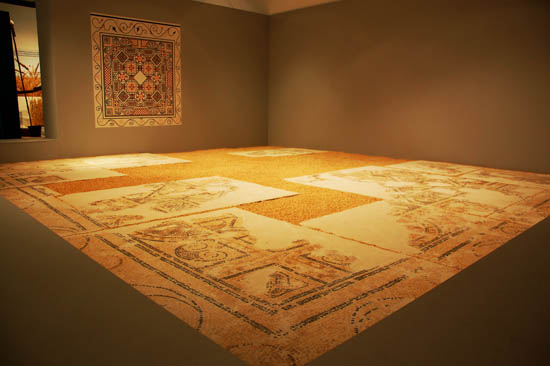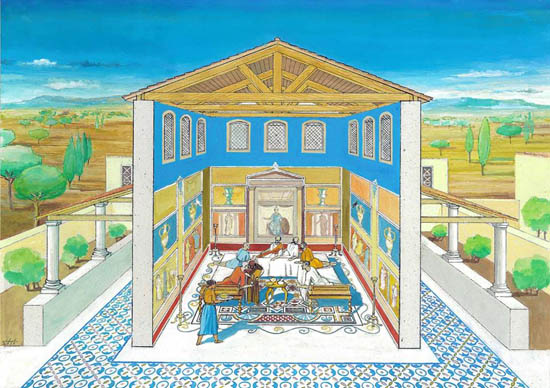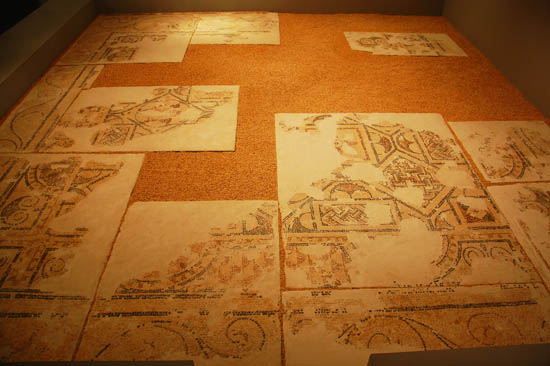 The restored mosaic in the dining room of the villa Roman Abicada is the new acquisition of the Museum of Portimão. From today onwards, the colorful mosaic that once covered the floor in one of the rooms of the house of the rich Roman owners who for about 2000 years lived with the Ria de Alvor at their feet can be seen in the context of the temporary exhibition “The Mediterranean so close”.
The restored mosaic in the dining room of the villa Roman Abicada is the new acquisition of the Museum of Portimão. From today onwards, the colorful mosaic that once covered the floor in one of the rooms of the house of the rich Roman owners who for about 2000 years lived with the Ria de Alvor at their feet can be seen in the context of the temporary exhibition “The Mediterranean so close”.
The Roman house would be quite sumptuous, as can be seen in the recreations featured in the exhibition. But what remains of this and other mosaics is not much. “This is the first opportunity to see what is left of the mosaic in the dining room. What is not there, the gaps in the mosaic, are a consequence of time, but also of human action," he explained to Sul Informação José Gameiro, scientific director of the Portimão Museum.

"For a long time, it was thought that it was enough to excavate an archaeological site and leave it in plain sight, in the open," he laments. Now, these mosaics were not made to be uncovered, but indoors. A few short decades of sunbathing, rain, temperature changes and being trampled – and stolen… – by visitors, contributed more to its destruction than the nearly two thousand years it will have been buried, after the house is abandoned.
Hence, José Gameiro says that, «if he had not been removed from the villa, there would no longer be anything from the mosaic of Abicada».
This mosaic, made of thousands of small colored stones – the weavers – forming geometric designs, was recovered thanks to an agreement between the Museum of Portimão and the Regional Directorate of Culture of the Algarve. The Museum provided the space - a warehouse that serves to store reserves and for quarantine, in the Coca Maravilhas area -, the Regional Directorate paid the specialized work of a company contracted for the purpose.
Another of the various mosaics from villa Abicada, that of one of its apartments (bedroom), is now also being restored. But the protocol with the Regional Directorate of Culture, which is responsible for the Abicada, classified as a national monument, does not foresee, for the time being, any further restoration.
 The ideal, admits the director of the Portimão Museum, would be for all the mosaics to return, one day, to the villa Roman, to be appreciated there by visitors to the monument, which today has little or nothing to see. But this can only happen when, in the Abicada, an interpretative center similar to the one already existing in the neighboring megalithic monuments of Alcalar is created. And, above all, when a structure is built to protect the ruins of the Roman house from the aggressions of time.
The ideal, admits the director of the Portimão Museum, would be for all the mosaics to return, one day, to the villa Roman, to be appreciated there by visitors to the monument, which today has little or nothing to see. But this can only happen when, in the Abicada, an interpretative center similar to the one already existing in the neighboring megalithic monuments of Alcalar is created. And, above all, when a structure is built to protect the ruins of the Roman house from the aggressions of time.
All of this is in the plans of the Regional Directorate of Culture, but it will have to wait for more prosperous times.
The inclusion of the restored mosaic in the temporary exhibition “The Mediterranean so close”, on display at the Portimão Museum, is part of the commemorations of the European Heritage Days, which begin this Friday, the 26th, and continue until Sunday, the 28th.
To find out what will happen in Portimão, click here, or, to find out what's going on in the Algarve and Baixo Alentejo, click below on the “European Heritage Days” tag.

















Comments